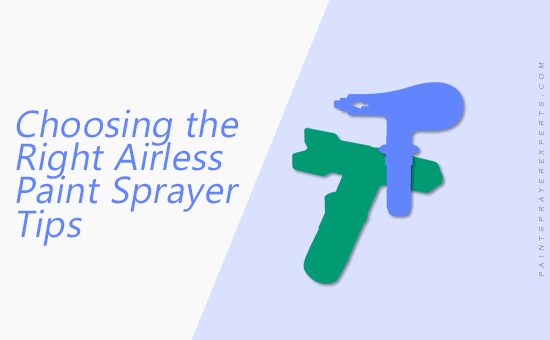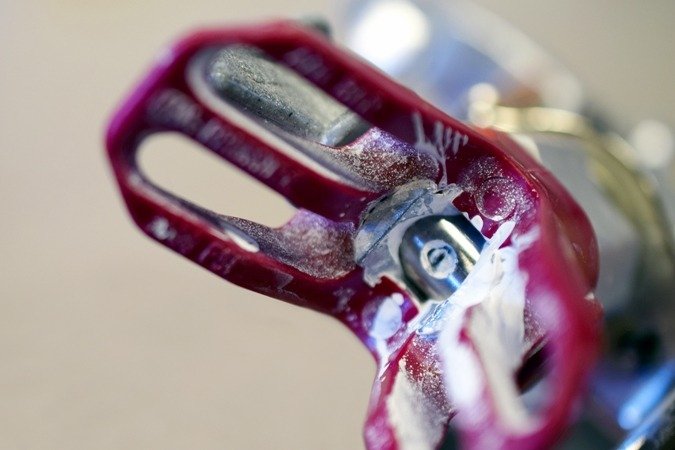
Choosing the right airless paint sprayer tips may be the ultimate decision for the outcome of your paint job. The size of the tip that you will use determines both the size of the paint droplets that come out of the gun and the amount of fluid that escapes once you pull the trigger.
While many paint manufacturers specify the appropriate tip size for the type of paint you’re getting, it is generally advisable for painters to get familiar with choosing tip sizes for themselves.
To this end, we’re providing an in-depth explanation below on not just how to choose the perfect airless paint sprayer tips, but also how to read the tip codes, how to maintain the tips, and we also will answer a few questions regarding interchanging tips for more flexibility.
Airless Paint Sprayer Tips Numbering Codes
You probably already noticed that all tips come with some numbers engraved. To be able to select the appropriate tip for your airless paint sprayer, you must first understand the principle behind each numbering.
Airless paint sprayer tips are numbered in three digits, such as “515”, for example. All these numbers signify the rating for a particular property, which we will explain more in-depth below.
First Digit
The first digit, the number five, in our example, indicates the angle in the opening through which the gun sprays the material.
After the first digit, you should always add a zero to specify the actual angle. This means that, in our example, the number 5 is indeed 50, indicating an angle of specifically 50 degrees.
A tip numbering of, say, 419, would indicate an opening angle of 40 degrees. With the same principle, a 317 tip would indicate a 30-degree angle opening, so you get the idea.
The first number also determines the fan width, which is the width covered by the spray when the gun is held perpendicular to the surface at a distance of 12 inches (30 cm).
To get this value, all you have to do is multiply by 2 (imperial system) or by 5 (metric system).
In our case, our fan width will be 5 (the first digit) multiplied by 2 (a constant) to give a fan width of 10 inches, or by 5 (constant) to give 25 cm, indicating a fan width of 25 cm.
If we have a 419 tip, the fan width would be 4 multiplied by 2, which makes a fan width of 8 inches (or 4*5=20cm)
The Second and Third Digit
The second and third digit, unlike the first, are read together. They indicate the diameter of the hole in the tip through which flows the paint material, also called the orifice.
To keep on with our earlier example of a 515 spray tip where we already found out the opening angle and fan width using the first number, the diameter can then be determined by the last two numbers, 1 and 5.
This is done by dividing the number by 1000, such that “15” becomes 0.015 inches. You can then convert the inches into centimeters if needed, by multiplying the orifice size by 2.54, so that our 0.015 inches become 0.0375 cm.
How to determine the coating thickness
By knowing the orifice size and the fan-width, we can determine how thick of a coating we will spray.
To make a comparison, let’s take a 515 tip and a 315 tip. They both have an orifice size of 0.015 inches but different fan widths.
The 515 tip sprays a 10-inch wide fan, while the 315 tip sprays a 6-inch wide fan.
Taking into consideration that the same amount of paint will leave the orifice, the 515-tip will spray a thinner coating.
How to choose the right Airless Paint Sprayer Tips
Choosing the right airless paint sprayer tip also depends on the spray project and the coating type you will be working with.
Since airless paint sprayer tips are extremely small in size, the thickness and texture of the coating both play a big role.
Paint manufacturers are aware of this, and as such, they almost always include the specifications about the most appropriate tip size for each paint and coating.
Rule of thumb: Lighter coatings require smaller tips, while heavy coatings require larger tip sizes.
Examples of light coatings compatible with smaller tips are lacquers, enamels, and stains, while heavier coatings are elastomeric and block filler paints.
General Guidelines
There are many types of sprayer tips. Below you’ll find some of the most popular ones, followed by their suggested use.
- 211 Sprayer Tips
The 211 spray tips are recommended for working with lighter paint types. An example of scenarios to use this is when working with beams and windows.
- 415 Sprayer Tips
For painting large surfaces such as ceilings, 411 spray tips are generally more preferable. Lacquer is an example of a material compatible with the 411 tips.
- 515 Sprayer Tips
515 are appropriate for large spray projects such as painting rooms and houses.
How to clean the Airless Paint Sprayer Tips

Cleaning the tips is as important as cleaning the gun itself because clogged tip holes make the device virtually impossible to use. The appropriate time to clean your paint sprayer tip is right after using it.
This is done after cleaning the sprayer with a flusher. Once this is done, you put the tip back on, insert it in the reverse position, turn up the pressure, and pull the trigger to flush out clogged paint inside the tip.
Managing Airless Paint Sprayer Tips
Even though the airless sprayer tips are made of abrasive-resistant materials, they will inevitably wear out at some point.
If you’re noticing lighter or darker bands of paint, decreased fan width, or you’re using more paint than usual, it’s probably time to change the tip.
Once you start to test your sprayer, as recommended every time before you begin the actual project, always check to see that the coating material coming out of the gun is in the right quantity and width that you desire.
If not, first try to adjust the pressure, and if regulating the pressure doesn’t quite do a lot, then you should consider changing the tip.
Are Airless Paint Sprayer Tips Interchangeable?
Even though the tip washers can be rubber or plastic depending on the manufacturer, usually the tip seats are of the same size, so yes, airless paint sprayer tips are interchangeable.
If you have a Graco paint sprayer but you’re not happy with Graco’s airless paint sprayer tips, you can use, for example, Titan tips.
This is not always the case though. Make sure to do a test spray before starting the actual spray project to check if the tips you’re using are compatible with your paint sprayer.
Conclusions
The point of airless paint sprayer tips coming in different sizes is to offer the required level of flexibility, which can only be acquired by finding the perfect one for a particular job/paint material.
Tips should also be changed once they’re old and not as effective as they were. Some tips tend to last longer than others. This mainly depends on the manufacturer that produced them and of course, the price. Using a worn sprayer tip can cost you more than buying a new one because of the wasted paint, so make sure to change the tips regularly for a better finishing job and fewer expenses.

Great overview this is what I needed to choose the right tip for my project. Thanks